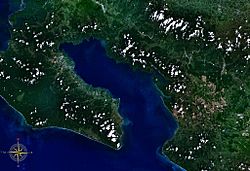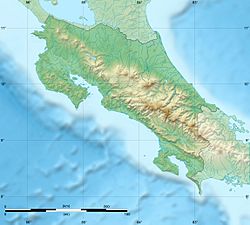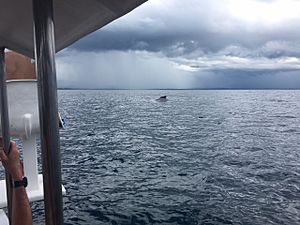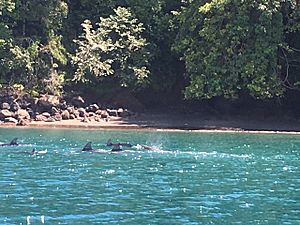Golfo Dulce, Costa Rica facts for kids
Quick facts for kids Golfo Dulce, Costa Rica |
|
|---|---|

Golfo Dulce seen from space
|
|
| Coordinates | 8°35′00″N 83°16′00″W / 8.58333°N 83.26667°W |
Golfo Dulce (which means "Sweet Gulf" in English) is a special gulf located in Costa Rica. It's found in the southern part of the Puntarenas Province. This unique inlet starts from the Pacific Ocean and stretches inland, separating the Osa Peninsula from the main part of Costa Rica.
Protecting Nature
Piedras Blancas National Park
In the northern part of Golfo Dulce, you'll find the Piedras Blancas National Park. This park protects about 14,000 hectares (35,000 acres) of amazing rainforest. This type of tropical forest is very rare and important. The park was created in 1992 to connect with the Corcovado National Park. This connection helps animals move freely and keeps the different kinds of plants and animals healthy.
Shark Sanctuary
In 2018, the Costa Rican government made a special protected area in Golfo Dulce for the scalloped hammerhead shark. This area is like a "no-take" zone, meaning fishing is not allowed there. It's the first shark sanctuary in Costa Rica! Scientists from an organization called Misión Tiburón discovered that adult hammerhead sharks travel from Cocos Island to Golfo Dulce. The calm waters and mangroves of Golfo Dulce are perfect "nurseries" where baby sharks can grow up safely. Protecting this area helps stop these endangered sharks from being caught by accident in fishing nets.
Mission Blue Hope Spot
Golfo Dulce was named a "Mission Blue hope spot" in 2019. This means it's recognized as a really important part of the ocean that needs protection. Mission Blue is an organization started by Sylvia Earle, a famous ocean explorer. They highlight places that are vital for the health of our oceans. Golfo Dulce is home to many amazing sea creatures, including the scalloped hammerheads, humpback whales, and four different kinds of dolphins.
Amazing Ecosystem
What is a Tropical Fjord?
Golfo Dulce is often called a "tropical fjord." This is very rare! A fjord is usually a long, narrow inlet of the sea between high cliffs, often found in cold places. But Golfo Dulce is tropical, with an average temperature of about 86 degrees Fahrenheit (30 degrees Celsius). This area is super rich in nature, with 17 protected reserves. It holds about half of all the different plants and animals found in Costa Rica! It also gets a lot of rain, about five to six meters per year. The ecosystem here has two main parts: the marine (ocean) part and the terrestrial (land) part.
Marine Life in the Gulf
The marine ecosystem of Golfo Dulce is full of life! It's home to many sea mammals, reptiles, fish, sharks, and tiny creatures without backbones (invertebrates).
Marine Mammals
Many types of whales visit Golfo Dulce. They use it as a safe place to have their babies and raise them. The warm water and plenty of small fish and plankton make it a perfect nursery. You might see Humpback Whales, Spotted Dolphins, Bottlenose Dolphins, and even Orcas here!
Reptiles
Sea turtles are common marine reptiles in the gulf. Several species live here, like the Pacific Green Sea Turtle, Olive Ridley, Hawksbill, and Pacific Leatherback. They love the warm water and the jellyfish and plants they eat. You can also find yellow-bellied sea snakes, saltwater caimans, and saltwater crocodiles in the area.
Sharks and Other Fish
Golfo Dulce is home to several shark species, including the huge Whale Shark, Scalloped Hammerhead, and various Rays. Other large fish like Needle Fish, Dorados, and Marlins also swim in these waters.
Invertebrates
Many small creatures without backbones live in Golfo Dulce. These include jellyfish, Portuguese Man-O-Wars, sea stars, colorful coral reefs, crabs, and sea mollusks.
Land Life Around the Gulf
The land around Golfo Dulce is just as lively as the water! About two to three percent of the plants found here grow nowhere else on Earth. This land ecosystem has many reptiles, birds, amphibians, insects, and mammals.
Land Reptiles
On land, you can find Iguanas, Saltwater Caimans, and Saltwater Crocodiles. There are also many types of snakes, some venomous and some not, and several kinds of geckos.
Birds
The most common birds you'll see here are the bright Scarlet Macaw and the colorful Toucan.
Amphibians
Amphibians like toads, skinks, and even poison dart frogs live near fresh water sources like rivers and lakes. The Golfo Dulce Poison Dart Frog is a special kind found only here, but it is endangered.
Mammals
All four types of monkeys found in Costa Rica live in this ecosystem: the Central American squirrel monkey, the Geoffrey's spider monkey, the Mantled howler monkey, and the White-headed capuchin monkey.
Challenges to the Ecosystem
Even though Costa Rica tries hard to protect its beautiful nature, Golfo Dulce faces some threats. In some populated areas like Pavones and Golfito, pollution from garbage can harm both the land and sea animals. Trash often ends up in rivers and then flows into the ocean. This can trap animals, or they might eat harmful plastics. Chemicals from plastics can also get into the water.
Another problem is deforestation in areas that are not protected. For example, where palm oil plantations are grown, like in Golfito, the natural jungle is cut down to plant palm oil trees. While this helps the economy, it destroys many plants and forces animals to leave their homes or even kills them.
Places Around the Gulf
Four main areas surround Golfo Dulce: Golfito, Pavones, Zancudo, and the Osa Peninsula.
Golfito
Golfito is a town located west of Golfo Dulce. Its economy mostly relies on the large palm oil farms nearby. Golfito also has a small airport for flights within Costa Rica and northern Panama.
Zancudo
Zancudo is a quiet shoreline northwest of Golfo Dulce. It attracts visitors with its beautiful beaches and natural scenery. It's one of the less crowded areas in Costa Rica.
Osa Peninsula
The Osa Peninsula is east of Golfo Dulce. It has the largest protected natural areas around the gulf, which makes it popular for "eco-tourists" (people who travel to enjoy nature). The Osa Peninsula is also famous for its surfing spot called Matapalo.
Pavones
Pavones is located south of Golfo Dulce. The town's economy is mainly based on local fishing, but it also attracts many eco-tourists and surfers. Pavones is a great place for hikers and has the second-longest "point break" in the world, which brings in many surfers.
What's in a Name?
Sometimes in English books, Golfo Dulce is mistakenly called "Gulf of Dulce." But the correct translation is "Sweet Gulf." However, people locally and internationally always use the original name, "Golfo Dulce."
See also
 In Spanish: Golfo Dulce para niños
In Spanish: Golfo Dulce para niños




